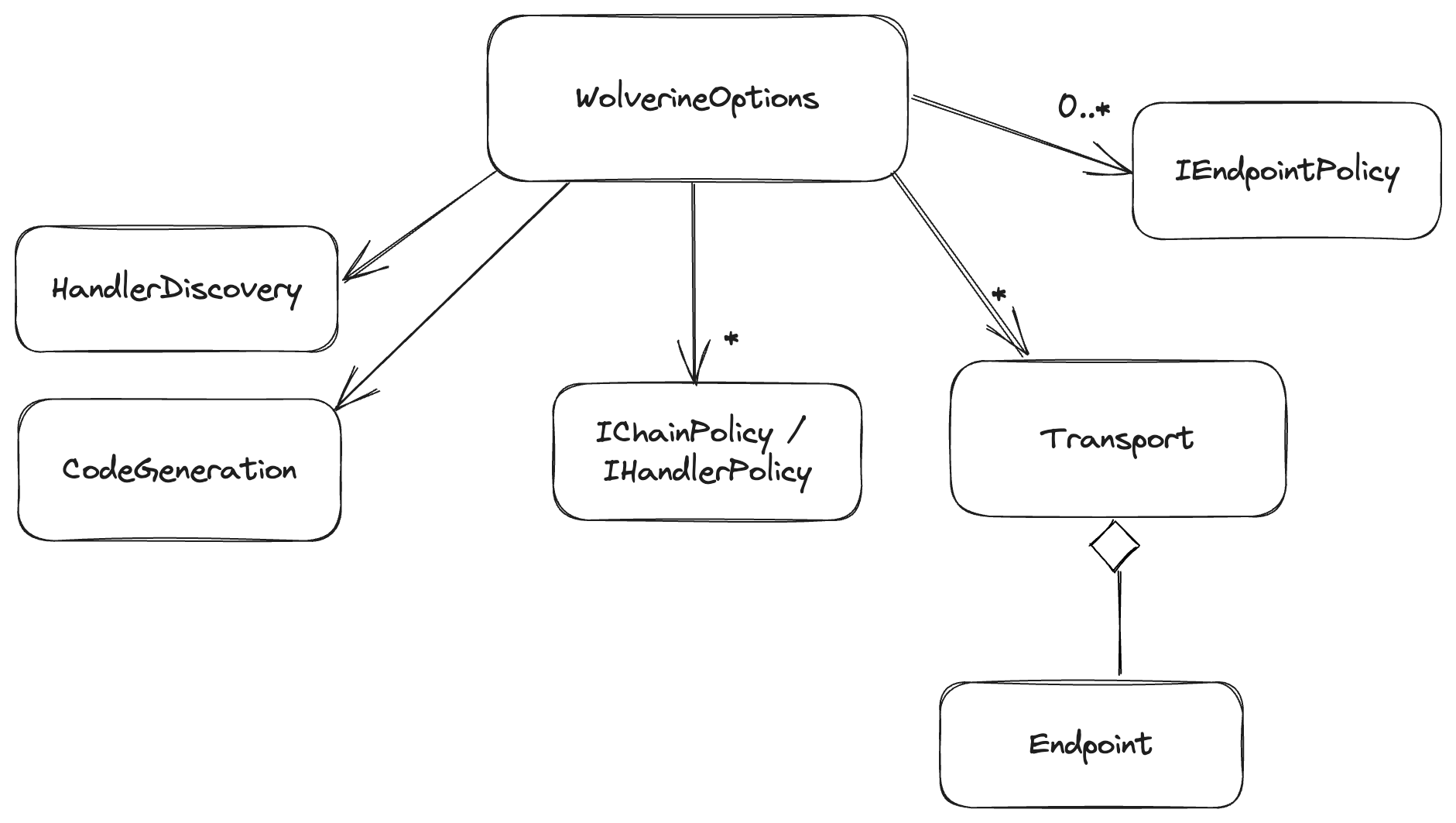Configuration
INFO
As of 3.0, Wolverine does not require the usage of the Lamar IoC container, and will no longer replace the built in .NET container with Lamar.
Wolverine 3.0 is tested with both the built in ServiceProvider and Lamar. It's theoretically possible to use other IoC containers now as long as they conform to the .NET conforming container, but this isn't tested by the Wolverine team.
Wolverine is configured with the IHostBuilder.UseWolverine() or HostApplicationBuilder extension methods, with the actual configuration living on a single WolverineOptions object. The WolverineOptions is the configuration model for your Wolverine application, and as such it can be used to configure directives about:
- Basic elements of your Wolverine system like the system name itself
- Connections to external messaging infrastructure through Wolverine's transport model
- Messaging endpoints for either listening for incoming messages or subscribing endpoints
- Subscription rules for outgoing messages
- How message handlers are discovered within your application and from what assemblies
- Policies to control how message handlers function, or endpoints are configured, or error handling policies

With ASP.NET Core
INFO
Do note that there's some additional configuration to use WolverineFx.HTTP as well.
Below is a sample of adding Wolverine to an ASP.NET Core application that is bootstrapped with WebApplicationBuilder:
using JasperFx;
using Quickstart;
using Wolverine;
var builder = WebApplication.CreateBuilder(args);
// The almost inevitable inclusion of Swashbuckle:)
builder.Services.AddEndpointsApiExplorer();
builder.Services.AddSwaggerGen();
// For now, this is enough to integrate Wolverine into
// your application, but there'll be *many* more
// options later of course :-)
builder.Host.UseWolverine();
// Some in memory services for our application, the
// only thing that matters for now is that these are
// systems built by the application's IoC container
builder.Services.AddSingleton<UserRepository>();
builder.Services.AddSingleton<IssueRepository>();
var app = builder.Build();
// An endpoint to create a new issue that delegates to Wolverine as a mediator
app.MapPost("/issues/create", (CreateIssue body, IMessageBus bus) => bus.InvokeAsync(body));
// An endpoint to assign an issue to an existing user that delegates to Wolverine as a mediator
app.MapPost("/issues/assign", (AssignIssue body, IMessageBus bus) => bus.InvokeAsync(body));
// Swashbuckle inclusion
app.UseSwagger();
app.UseSwaggerUI();
app.MapGet("/", () => Results.Redirect("/swagger"));
// Opt into using JasperFx for command line parsing
// to unlock built in diagnostics and utility tools within
// your Wolverine application
return await app.RunJasperFxCommands(args);"Headless" Applications
TIP
The WolverineOptions.Services property can be used to add additional IoC service registrations with either the standard .NET IServiceCollection model syntax.
For "headless" console applications with no user interface or HTTP service endpoints, the bootstrapping can be done with just the HostBuilder mechanism as shown below:
return await Host.CreateDefaultBuilder(args)
.UseWolverine(opts =>
{
opts.ServiceName = "Subscriber1";
opts.Discovery.DisableConventionalDiscovery().IncludeType<Subscriber1Handlers>();
opts.ListenAtPort(MessagingConstants.Subscriber1Port);
opts.UseRabbitMq().AutoProvision();
opts.ListenToRabbitQueue(MessagingConstants.Subscriber1Queue);
// Publish to the other subscriber
opts.PublishMessage<RabbitMessage2>().ToRabbitQueue(MessagingConstants.Subscriber2Queue);
// Add Open Telemetry tracing
opts.Services.AddOpenTelemetryTracing(builder =>
{
builder
.SetResourceBuilder(ResourceBuilder
.CreateDefault()
.AddService("Subscriber1"))
.AddJaegerExporter()
// Add Wolverine as a source
.AddSource("Wolverine");
});
})
// Executing with Oakton as the command line parser to unlock
// quite a few utilities and diagnostics in our Wolverine application
.RunOaktonCommands(args);As of Wolverine 3.0, you can also use the HostApplicationBuilder mechanism as well:
var builder = Host.CreateApplicationBuilder();
builder.UseWolverine(opts =>
{
var connectionString = builder.Configuration.GetConnectionString("database");
opts.Services.AddDbContextWithWolverineIntegration<SampleDbContext>(x =>
{
x.UseSqlServer(connectionString);
});
// Add the auto transaction middleware attachment policy
opts.Policies.AutoApplyTransactions();
});
using var host = builder.Build();
await host.StartAsync();And lastly, you can just use IServiceCollection.AddWolverine() by itself.
Replacing ServiceProvider with Lamar
If you run into any trouble whatsoever with code generation after upgrading to Wolverine 3.0, please:
- Please raise a GitHub issue in Wolverine with some description of the offending message handler or http endpoint
- Fall back to Lamar for your IoC tool
To use Lamar, add this Nuget to your main project:
dotnet add package Lamar.Microsoft.DependencyInjectionIf you're using IHostBuilder like you might for a simple console app, it's:
// With IHostBuilder
var builder = Host.CreateDefaultBuilder();
builder.UseLamar();In a web application, it's:
var builder = WebApplication.CreateBuilder(args);
builder.Host.UseLamar();and with HostApplicationBuilder, try:
var builder = Host.CreateApplicationBuilder();
// Little ugly, and Lamar *should* have a helper for this...
builder.ConfigureContainer<ServiceRegistry>(new LamarServiceProviderFactory());Splitting Configuration Across Modules 5.0
To keep your UseWolverine() configuration from becoming too huge or to keep specific configuration maybe within different modules within your system, you can use Wolverine extensions.
You can also use the IServiceCollection.ConfigureWolverine() method to add configuration to your Wolverine application from outside the main UseWolverine() code as shown below:
var builder = Host.CreateApplicationBuilder();
// Baseline Wolverine configuration
builder.Services.AddWolverine(opts =>
{
});
// This would be applied as an extension
builder.Services.ConfigureWolverine(w =>
{
// There is a specific helper for this, but just go for it
// as an easy example
w.Durability.Mode = DurabilityMode.Solo;
});
using var host = builder.Build();
host.Services.GetRequiredService<IWolverineRuntime>()
.Options
.Durability
.Mode
.ShouldBe(DurabilityMode.Solo);
